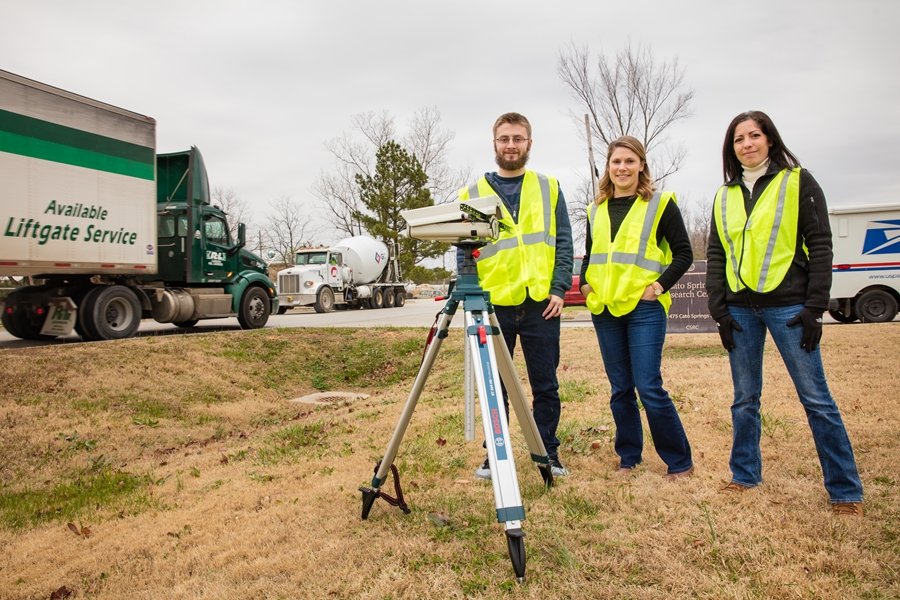System Will Help Planners Identify, Prioritize Highway Projects

Sarah Hernandez, center, with students Collin Burris, left, and Magdalena Asborno, right
FAYETTEVILLE, Ark. – A new prototype system that monitors the number and type of tractor-trailers moving through a region could help transportation planners identify and prioritize infrastructure projects and increase operational efficiency.
“Transportation planners need better information about truck characteristics and commodity flows to make difficult decisions in selecting and prioritizing projects,” said Sarah Hernandez, assistant professor of civil engineering in the College of Engineering at the University of Arkansas. “While there are sensor technologies that provide estimates of truck volumes, these systems are limited by poor pavement conditions and don’t provide the level of detail needed for effective planning. Our non-intrusive system is capable of more complex data collection and is not affected by adverse road conditions.”
Hernandez; Magdalena Asborno, a doctoral student and graduate research assistant in civil engineering; and Collin Burris, an undergraduate student in computer science and computer engineering, used inexpensive, single-beam LIDAR sensors deployed along busy highway sites in Arkansas to gather information about the quantity and types of tractor-trailers moving through those areas. Similar to radar, LIDAR uses pulsed, infrared laser light to detect distant objects and measure the distance to those objects. The sensors were mounted on tripod stands next to the highway and about four feet off the ground, so they could monitor several lanes of traffic and did not depend on road conditions for accuracy or reliability.
Time-stamped measurements recorded by the LIDAR sensors allowed the researchers to generate “signatures,” and matched these signatures to the shapes of individual vehicles.
The prototype captured five distinct body types of tractor trailers with high accuracy rates, and the researchers are refining the system and expanding the data model to identify up to 50 unique types of trailer bodies.
Knowledge of the body type provides information on the commodities transported through a region. For example, monitoring the movements of hoppers, the type of trucks that carry rice and soybeans – two crops critical to the state of Arkansas – could explain how and when farmers are transporting these commodities to market This, in turn, could help transportation planners decide the best methods to alleviate transportation bottlenecks that affect certain industries, such as agriculture.
A system that provides knowledge of truck body type could also inform decisions on whether or when to expand highways or develop new routes and how to implement policies to promote a shift to rail or water, the latter involving strategically locating a port or other intermodal facilities.
“Our goal is to work with very low-cost technology so we can achieve widescale deployment,” Hernandez said. “For example, with a $1,000 sensor, the Arkansas Department of Transportation could deploy 100 sensors across the network, rather than using $10,000 sensors at only 10 locations. We get better coverage this way and thus better insight into truck movements.”
An article about the prototype was published in Transportation Research Record.
About the University of Arkansas: The University of Arkansas provides an internationally competitive education for undergraduate and graduate students in more than 200 academic programs. The university contributes new knowledge, economic development, basic and applied research, and creative activity while also providing service to academic and professional disciplines. The Carnegie Foundation classifies the University of Arkansas among only 2.7 percent of universities in America that have the highest level of research activity. U.S. News & World Report ranks the University of Arkansas among its top American public research universities. Founded in 1871, the University of Arkansas comprises 10 colleges and schools and maintains a low student-to-faculty ratio that promotes personal attention and close mentoring.
Topics
Contacts
Sarah Hernandez, Assistant Professor, Civil Engineering
College of Engineering
479-575-4182,
sarahvh@uark.edu
Magdalena Asborno, Doctoral Student and Graduate Research Assistant, Civil Engineering
College of Engineering
479-276-4841,
miasborn@email.uark.edu
Matt McGowan, science and research communications officer
University Relations
479-575-4246,
dmcgowa@uark.edu
Headlines
PetSmart CEO J.K. Symancyk to Speak at Walton College Commencement
J.K. Symancyk is an alumnus of the Sam M. Walton College of Business and serves on the Dean’s Executive Advisory Board.
Faulkner Center, Arkansas PBS Partner to Screen Documentary 'Gospel'
The Faulkner Performing Arts Center will host a screening of Gospel, a documentary exploring the origin of Black spirituality through sermon and song, in partnership with Arkansas PBS at 7:30 p.m. Thursday, May 2.
UAPD Officers Mills and Edwards Honored With New Roles
Veterans of the U of A Police Department, Matt Mills has been promoted to assistant chief, and Crandall Edwards has been promoted to administrative captain.
Community Design Center's Greenway Urbanism Project Wins LIV Hospitality Design Award
"Greenway Urbanism" is one of six urban strategies proposed under the Framework Plan for Cherokee Village, a project that received funding through an Our Town grant from the National Endowment for the Arts.
Spring Bike Drive Refurbishes Old Bikes for New Students
All donated bikes will be given to Pedal It Forward, a local nonprofit that will refurbish your bike and return it to the U of A campus to be gifted to a student in need. Hundreds of students have already benefited.




